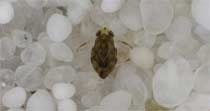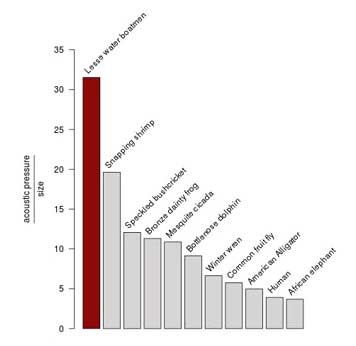Earth's loudest animal: a tiny European insect
04 Jul 2011
An insect found across Europe is the loudest animal on earth relative to its body size, according to a study, that says the tiny aquatic creature can sing at up to 99.2 decibels, the equivalent to the sound of a loud orchestra from the front row.
 The freshwater micronecta scholtzi, commonly known as the water boatman, measures just 2mm and is very common in Europe. What is extraordinary about the ability of the M schlotzi is that the area they use to create sound only measures about 50 micrometres across, roughly the width of a human hair.
The freshwater micronecta scholtzi, commonly known as the water boatman, measures just 2mm and is very common in Europe. What is extraordinary about the ability of the M schlotzi is that the area they use to create sound only measures about 50 micrometres across, roughly the width of a human hair.
The majority of the loudest animals on Earth are also the biggest, with blue whale songs reaching 188 dB and elephant's rumbling calls measuring 117 dB.
Although remarkable acoustic signals are made by a range of invertebrates, including the miniature cricket and preying mantis, and by large mammals, none compare to M. scholtzi once body size is taken into account.
The insect produces the din by rubbing its penis against its abdomen in a process called "stridulation". According to researchers the song is a courtship display performed to attract a mate.
Using special underwater microphones, the team of biologists and engineering experts found that the insects songs' on an average hit 78.9 decibels which compares to the noise level of a passing freight train.
According to engineering expert, Dr James Windmill from the University of Strathclyde, Glasgow, the team was very surprised as it first thought that the sound was from larger aquatic species such as a Sigara species of lesser water boatmen.
Stridulation refers to the act of rubbing two body parts together to produce a sound. Resonating sounds are produced when a ridge is rubbed across a finely ridged surface and in insects it is most commonly associated with grasshoppers and crickets. However, some beetles, bugs and even spiders are known to chirp, chirrup and hiss in this way.
According to Dr Windmill the reason the insects did not deafen people was due to the bug's underwater lifestyle.

Though around 99 per cent of the sound is lost, while transferring from water to air, the songs were sill loud enough to be audible to the human ear.
Dr Windmill said the song was so loud that a person walking along the bank can actually hear these tiny creatures singing from the bottom of the river.
The water boatmen produce the deafening sound by rubbing a ridge on their penis across the ridged surface of their abdomen.
According to Dr Windmill, not much is known about how the insects make such a loud sound using such a small area.
With no obvious means to amplify the sound, the question of how the animals physically make such a loud call remains a mystery.
Dr Windmill says the bugs create sound at very high level and it could be very useful for future ultrasonic systems to learn how they do that.
The researchers are now keen to bring together aspects of biology and engineering to clarify how and why such a small animal makes such a loud noise, and to explore the practical applications.
Dr Windmill added: ''Biologically this work could be helpful in conservation as recordings of insect sounds could be used to monitor biodiversity. From the engineering side it could be used to inform our work in acoustics, such as in sonar systems.''






























